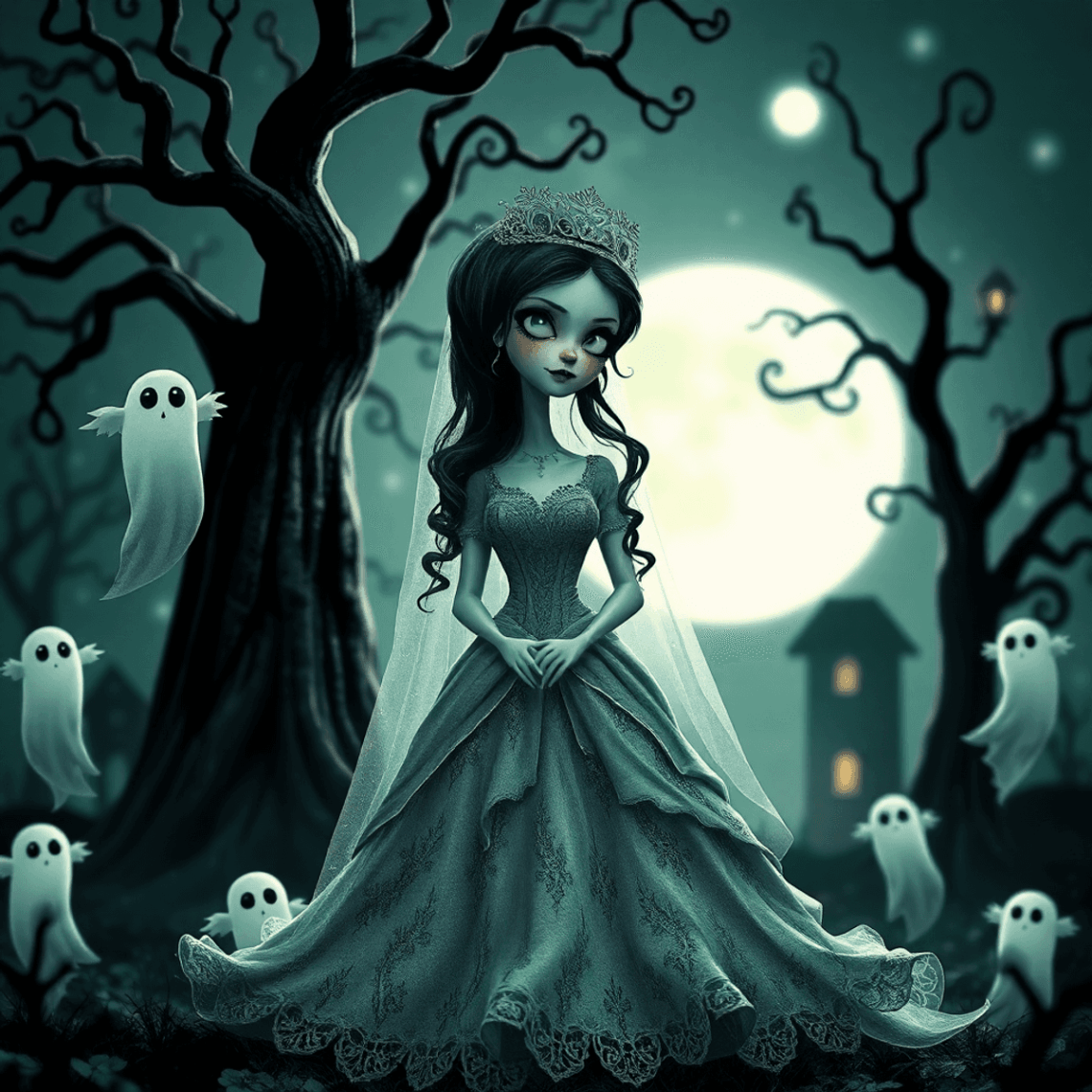Introduction
Corpse Bride is a haunting masterpiece in the world of animation, bringing Tim Burton’s signature gothic style to life through mesmerizing stop-motion artistry. Released in 2005, this dark fantasy musical weaves a tale of love, death, and redemption in a Victorian-era setting.
In this guide, you’ll discover:
- The creative minds behind this animated gem
- A deep dive into the film’s enchanting plot
- The groundbreaking animation techniques used
- The impact of Danny Elfman’s musical score
- The movie’s critical reception and cultural legacy
Whether you’re a long-time Burton fan or new to this gothic romance, you’ll uncover the intricate details that make Corpse Bride a beloved addition to animated cinema.
The Creative Team Behind “Corpse Bride”
The creative genius behind “Corpse Bride” emerged from a collaboration between Tim Burton Productions and Laika Entertainment. Tim Burton, known for his distinctive gothic aesthetic, co-directed the film with Mike Johnson, bringing his signature dark fantasy style to life through stop-motion animation.
Burton’s creative vision found perfect synergy with Mike Johnson’s expertise in stop-motion animation. Johnson’s previous work on projects like “The PJs” and “James and the Giant Peach” made him an ideal partner for this ambitious undertaking.
The screenplay came to life through the combined talents of three accomplished writers:
- John August – A frequent Burton collaborator who previously worked on “Big Fish”
- Caroline Thompson – The creative mind behind “Edward Scissorhands” and “The Nightmare Before Christmas”
- Pamela Pettler – A skilled screenwriter who later worked on “Monster House” and “9”
The character designs originated from Carlos Grangel, whose artistic prowess shaped the distinctive look of both the living and dead characters. His work established the visual foundation that would define the film’s unique aesthetic.
The production team’s dedication to detail extended beyond the creative aspects. Warner Bros. Pictures joined as the distributor, ensuring the film would reach audiences worldwide. This partnership between Tim Burton Productions and Laika Entertainment marked a significant milestone in stop-motion animation history.
Release Timeline and Premiere Details
“Corpse Bride” made its grand debut at the prestigious 62nd Venice International Film Festival on September 7, 2005. The film’s theatrical release followed a strategic rollout across different regions:
- United States: September 23, 2005
- United Kingdom: October 13, 2005
- Australia: December 1, 2005
- Japan: December 17, 2005
Warner Bros. Pictures orchestrated a limited release strategy, initially launching the film in 977 theaters across the United States. The positive audience response led to an expansion to 2,437 theaters by September 30, 2005.
The premiere event at Venice Film Festival garnered significant attention, with Tim Burton, Helena Bonham Carter, and other key cast members walking the red carpet. The film’s unique blend of stop-motion animation and gothic romance captured the interest of festival attendees, setting the stage for its successful theatrical run.
The home media release arrived on January 31, 2006, featuring both DVD and HD DVD formats. A Blu-ray version followed in 2006, offering viewers enhanced visual quality of the film’s intricate animation details.
Plot Summary: A Journey Through Life and Death
Corpse Bride follows Victor Van Dort, a shy and artistic young man from a nouveau riche family. His parents arrange his marriage to Victoria Everglot, the daughter of impoverished aristocrats seeking financial stability.
During a wedding rehearsal, Victor stumbles through his vows. Seeking solitude in the forest to practice, he places the ring on what appears to be a tree branch – it’s actually the skeletal finger of Emily, the Corpse Bride. She rises from her grave, accepting his accidental proposal, and whisks him away to the Land of the Dead.
The Land of the Dead presents a vibrant, colorful contrast to the grey Victorian world above. Here, Victor learns Emily’s tragic backstory: she was murdered by her former fiancé who stole her family jewels and left her for dead in the woods.
As Victor navigates between two worlds, he finds himself torn between his growing feelings for Victoria in the Land of the Living and his commitment to Emily in the Land of the Dead. His journey becomes increasingly complicated when Victoria’s parents arrange her marriage to the mysterious Lord Barkis Bittern, forcing Victor to make a choice that will affect both the living and the dead.
Character Analysis: Love, Loss, and Identity Crisis
Victor Van Dort: The Artist in Conflict
Victor Van Dort is a complex character torn between duty and desire. His shy personality and artistic sensibilities clash with the expectations society has placed on him. Throughout his journey, Victor evolves from a hesitant, anxious young man into someone who learns to embrace his true emotions and make tough decisions. His piano playing symbolizes his emotional state – initially restrained and precise, later becoming more passionate and free.
Emily: The Tragic Bride
Emily, the Corpse Bride, carries the burden of a tragic past. Murdered on her wedding night by her supposed lover, she still holds onto an unwavering belief in romance despite her heartbreak. Her character embodies both the beauty and pain of eternal devotion. Emily’s journey isn’t about finding love but rather learning to let it go – a poignant reflection of her growth beyond her tragic circumstances.
Victoria Everglot: The Understanding Partner
Victoria Everglot adds depth to what could have been a simple love triangle. Despite her privileged upbringing, she shares Victor’s appreciation for art and gentle nature. Their connection comes from genuine understanding rather than their arranged marriage:
Key Character Traits:
- Victor: Artistic, socially awkward, gains confidence
- Emily: Romantic, determined, learns to sacrifice for love
- Victoria: Patient, understanding, quietly rebellious
Intertwined Journeys
The interactions between these characters create a unique dynamic where love goes beyond life and death. Each character faces their own identity crisis:
- Victor struggles between his responsibility to the living and his bond with the dead
- Emily grapples with holding onto past dreams while accepting present reality
- Victoria challenges societal expectations to fight for true love
Their individual journeys intertwine to form a story that delves into the complexities of love, loss, and personal growth. The characters’ development reflects the film’s visual contrast between the vibrant Land of the Dead and the muted world of the living, emphasizing how each character discovers their true self through their experiences in both realms.
Themes Explored in “Corpse Bride”
“Corpse Bride” delves deep into the complexities of love that transcends mortality. The film presents a unique perspective on relationships by exploring connections between the living and the dead, challenging traditional notions of romantic bonds.
Unconventional Love
The theme of unconventional love manifests through:
- Emily’s unwavering devotion despite her death
- Victor’s internal struggle between two worlds
- The blurred lines between physical and spiritual connections
Loss
Loss emerges as a powerful driving force throughout the narrative. Each character grapples with different forms of loss:
- Emily’s loss of life and dreams
- Victor’s temporary loss of freedom
- Victoria’s loss of control over her destiny
Longing
The film masterfully portrays longing through its visual and narrative elements. This manifests in:
The Land of the Dead’s vibrant colors contrasting with the Living World’s muted tones, symbolizing the characters’ yearning for what they can’t have
Duality
The concept of duality runs throughout the story, reflected in:
- The stark contrast between the living and dead worlds
- The opposing nature of arranged marriages versus true love
- The battle between societal expectations and personal desires
Identity Crisis
An exploration of identity crisis shapes the characters’ journeys as they navigate between two worlds. This exploration manifests through:
- Victor’s struggle to fulfill his role as both a dutiful son and true romantic
- Emily’s transformation from victim to empowered spirit
- Victoria’s challenge to maintain her identity within rigid social constraints
The film’s gothic aesthetic serves as a perfect backdrop for these heavy themes, using visual metaphors to represent the characters’ internal struggles. Dark humor lightens these weighty topics while maintaining their emotional impact, creating a balanced exploration of life, death, and love.
The Unique Artistic Style and Animation Techniques of “Corpse Bride”
“Corpse Bride” is a masterpiece of stop-motion animation, created through meticulous frame-by-frame manipulation of physical puppets. Each character required multiple puppet versions, with Victor alone having 44 different heads to capture various expressions.
The Animation Process
The animation process involved:
- 30 active sets running simultaneously
- 300+ puppets and props
- 24 frames per second of film
- Weekly shooting target of 1-3 minutes of footage
Tim Burton’s Gothic Aesthetic
Tim Burton’s signature gothic style can be seen in every aspect of the film’s visual design. The Land of the Living has a washed-out color scheme with mostly greys and muted blues. In contrast, the Land of the Dead is bursting with bright colors like electric blues, deep purples, and rich greens.
Character Designs
The character designs reflect Burton’s distinctive style:
- Living Characters: Elongated figures with exaggerated features, pale skin tones
- Dead Characters: More fluid movements, brighter colors, elaborate costume designs
Technical Innovations
The film introduced several technical advancements:
- Digital capture technology for smoother animation
- LED lights embedded within puppets for enhanced expressions
- Custom-built mechanical rigs for complex movements
Set Design
The film’s sets feature miniature architectural elements inspired by Victorian-era design. Each location was hand-crafted to preserve the handmade look typical of stop-motion animation.
Danny Elfman’s Enchanting Musical Score for Corpse Bride
Danny Elfman’s musical score brings the haunting world of Corpse Bride to life through a masterful blend of Victorian-era melodies and Gothic undertones. His signature orchestral arrangements create distinct musical identities for both the Land of the Living and the Land of the Dead.
The soundtrack features several standout pieces that enhance the emotional depth of key scenes:
- “According to Plan” – A complex arrangement that introduces the main characters through interweaving melodies, highlighting the stark contrast between the Van Dort and Everglot families
- “Remains of the Day” – A jazz-inspired piece that transforms the Land of the Dead into a lively celebration, complete with skeleton jazz bands and dancing corpses
- “Tears to Shed” – A poignant ballad that captures Emily’s heartache and longing, featuring delicate piano melodies and haunting vocal harmonies
- “The Piano Duet” – A romantic piece that symbolizes Victor and Victoria’s connection through music, using intricate piano compositions
Elfman’s score employs specific musical techniques to enhance storytelling:
- Light, whimsical tones for scenes in the Land of the Living
- Rich, vibrant orchestrations for the Land of the Dead
- Recurring motifs that represent character relationships
- Strategic use of silence to amplify emotional moments
The musical score seamlessly integrates with the film’s dialogue and sound design, creating a rich auditory experience that complements the visual storytelling. Each musical piece serves as a narrative tool, guiding viewers through the emotional journey of Victor, Emily, and Victoria.
Critical Reception, Box Office Performance, and Awards Nominations
“Corpse Bride” received widespread critical acclaim when it was released in theaters in 2005. Critics praised the film’s:
- Unique visual style
- Emotional depth in storytelling
- Technical excellence in stop-motion animation
- Dark yet whimsical atmosphere
The film has an 84% approval rating on Rotten Tomatoes, with critics highlighting its imaginative world-building and gothic charm. Many reviewers made positive comparisons to Burton’s previous stop-motion work, “The Nightmare Before Christmas.”
Box Office Performance
The film performed well at the box office, indicating its commercial success:
- Opening weekend: $19.1 million
- Domestic earnings: $53.4 million
- International earnings: $64.7 million
- Total worldwide gross: $118.1 million
Awards Nominations
The film’s artistic achievements received significant recognition during awards season. Notable nominations include:
- Academy Award nomination for Best Animated Feature
- Annie Award nominations for:
- Best Character Animation
- Best Production Design
- Best Voice Acting
The British Academy of Film and Television Arts (BAFTA) recognized the film’s technical innovation with a nomination for Best Animated Film. “Corpse Bride” also received praise from the National Board of Review, which named it one of the year’s top animated films.
Cultural Impact and Legacy of “Corpse Bride”
“Corpse Bride” has changed the animation industry by pushing the limits of stop-motion techniques. The film’s mix of Victorian style and gothic elements inspired a new wave of dark fantasy animations, influencing works like “ParaNorman” and “Coraline.”
Influence on Animation
The film’s unique blend of Victorian aesthetics and gothic elements inspired a new wave of dark fantasy animations, influencing works like “ParaNorman” and “Coraline.”
Streaming Availability and Fanbase Growth
The film’s streaming availability on platforms like HBO Max and Netflix (region-dependent) has introduced it to new generations, building a dedicated fanbase that celebrates its artistry through:
- Fan art recreating the movie’s iconic scenes
- Cosplay interpretations of Emily and Victor
- Wedding themes inspired by the film’s aesthetic
- Musical covers of Danny Elfman’s soundtrack
Discussions Sparked by the Film
The movie’s impact extends beyond entertainment, sparking discussions about:
- The artistic potential of stop-motion animation
- Gothic romance in family-friendly content
- The representation of death in children’s media
- The fusion of horror and whimsy in storytelling
Influence on Fashion and Design
“Corpse Bride” has also left its mark on fashion and design, with its distinctive visual style inspiring:
- Gothic wedding dress designs
- Halloween costume collections
- Alternative fashion trends
- Contemporary art installations
Technical Achievements and Industry Standards
The film’s technical achievements have set new standards for puppet design and movement in stop-motion animation, serving as a reference point for animation students and professionals alike.
Conclusion: The Timeless Appeal of “Corpse Bride”
“Corpse Bride” is a testament to the power of innovative storytelling and artistic vision. The film’s unique blend of gothic romance, dark humor, and stop-motion mastery has created a lasting impression that resonates with audiences years after its release.
The question “What is Corpse Bride on?” extends beyond its platform availability – it’s a reflection of the film’s artistic achievement. You’ll find this masterpiece streaming on platforms like HBO Max and available for purchase on digital platforms such as Amazon Prime, iTunes, and Google Play.
Tim Burton’s distinctive style, combined with the haunting musical score and compelling narrative, has secured the film’s place in animation history. The story’s exploration of love, death, and sacrifice continues to captivate new generations of viewers, proving that well-crafted animation transcends time and age barriers.
The film’s enduring charm lies in its ability to balance darkness with light, humor with heart, creating an unforgettable experience that has become a cherished part of animation heritage.
FAQs (Frequently Asked Questions)
What is ‘Corpse Bride’ about?
‘Corpse Bride’ is an animated film directed by Tim Burton that explores themes of love, loss, and identity through the story of Victor Van Dort, who accidentally marries a deceased bride named Emily while navigating his arranged marriage to Victoria Everglot.
Who were the key creators behind ‘Corpse Bride’?
The film was brought to life by a talented creative team including Tim Burton, Mike Johnson, John August, Caroline Thompson, and Pamela Pettler, with production companies Tim Burton Productions and Laika Entertainment.
When was ‘Corpse Bride’ released?
‘Corpse Bride’ premiered on September 23, 2005, in the United States and has since become a notable entry in the realm of animated films.
What are the main themes explored in ‘Corpse Bride’?
The film delves into profound themes such as the love between the living and the dead, loss and longing, and identity crises faced by characters caught between two worlds.
How does Tim Burton’s artistic style influence ‘Corpse Bride’?
Tim Burton’s signature visual style is evident in ‘Corpse Bride’, particularly through its unique stop-motion animation techniques that create a whimsical yet dark aesthetic reflective of the film’s narrative.
What impact has ‘Corpse Bride’ had on animation culture?
‘Corpse Bride’ has significantly influenced the animation genre, fostering a dedicated fanbase and leaving a lasting impression on popular culture since its release.






